|
|
www.PrecisionStraightEdge.com
|
| Frequently Asked Questions |
|
| |
|
|
|
| Why can't I just use? |
| Flat Stock - Before I got into the precision straight edge business, I needed a straight edge to check the shape of a Blanchard grinder table that
I was regrinding. I didn't want to spend the $1,000 for a cast iron straight edge that my local gauge distributor
offered. I was very proud of myself when I ordered some Starret flat stock from MSC that was 36-inches long x ½" thick x 3" wide. Strarret's catalog guaranteed
the stock had a thickness tolerance of +/-0.001" with a width tolerance of -0.000"/+0.005" for a
price of less than $100. I figured that a couple of thousands was good enough for me. |
| |
|
|
|
After I received my package, I took it over to our
shops granite surface plate and was very disappointed to find that I could insert a 0.015 inch thick feeler between
the Starret flat stock and the surface plate because the steel was bowed like a banana.
I learned the tolerance listed in the catalog is for only the width measurement at any point along the stock. It
isn't a measure of the straightness of the stock as the same tolerance could apply to a piece of curved stock.
|
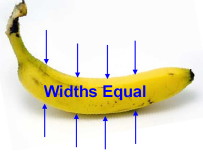
|
| |
|
|
|
| I finally took my bent Starret stock to a local grinding
shop for regrinding and asked them to hold a 0.001 inch flatness/straightness tolerance. They were finished grinding
my stock in about a week, it was now thinner at about 2-1/2 inches thick, and then told me they could only hold
0.0015 inches on the straight edge but still felt that another $150 was a fair price. I took it back to the shop's
granite plate, and found it really took about a 0.003 inch feeler to fill the gap. The grinding shop later told
me they had troubles with the stock twisting on their surface grinder. In retrospect, after a few years of grinding
straight edges, I can better understand their problem with this steel. We have re-ground several damaged Starret
brand official type straight edges since then, and they never seem to be very easy to grind and get back to flat. |
|
Laser Pointer - My next plan was to use a laser pointer to check spindle,
chuck and way alignment on grinding machines. The laser looked much lighter than a 30 pound straight edge. I made
up a mounting block that was square on the bottom with a hole to hold the laser. The first problem was that the
beam was too wide to check anything, so I poked a small pin hole into some foil to create a mask. I couldn't find
enough of a beam left to use. Next I shot the beam through a gap in a pair of blocks, spaced off by two 0.003 inch
shims. I would have never guessed that the horizontal gap between my blocks would create a vertical line on the
wall. Another failure, I couldn't even get to the stuff about measuring flatness deviation from the projected beam.
This laser idea really wasn't going anywhere for me.
Precison Laser Leveling System - I started looking at new machine laser systems, and soon
found there were about 30 thousand reasons, that I wasn't going to own one soon. Not much later a buddy of mine,
found a deal on a used machine quality laser system for about $5,000 on Ebay and things were looking up. |
| |
|
|
|
|
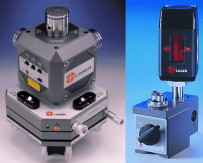
|
I must admit we all had great fun playing with this
laser ultra-precision leveling system. Steel straight edges by comparison are not very entertaining. Just move
the target to a measurement point on the surface and it displays the deviation of that point from the reference
point. We had a few problems until we learned that uneven temperature gradients in the shop caused by open doors,
fans, and hot equipment that effect the accuracy by causing "noise" in the readings. Depending on the
conditions, the display reading can fluctuate by as much as +/- .010 inch. This is optical effect is similar to
the rippling effect seen when looking down a paved road on a hot summer day. |
| |
|
|
|
| With a little practice it was actually possible to
use this Ebay laser to inspect parts. The parts were sent along with a printed inspection report that informed
customers it was from a laser. Customers seemed to accept it as the gospel truth of straightness certification.
Unfortunately one night an employee dropped the laser unit to the floor and it quit working. It would cost about
six thousand dollars just to repair the thing. Still it might have been worth fixing had it not been for a difficult
customer who had his own ideas about checking flatness and straightness using a co-ordinate measuring machine (CMM).
The now very dead laser and the customer's CMM had very different inspection results that were ultimately sorted
out by using an old fashioned precision straight edge. |
| |
| Leveling Lasers - I
recently had a chance to play with a construction type rotating laser with targets. The price on these units has
really declined now that they are available in hardware superstores. I found that these lasers ought to work out
just fine, if you only need to check straightness within a half inch or so and don't mind setting up and zeroing
the tripod a few dozen times. |
| |
|
|
|
|
| Co-ordinate Measuring Machine - The
CMM is the last word for inspection at most factories. They are expensive, and like consultants, the more they
cost, the less likely their results will be questioned. You can usually find them in a special little air conditioned
room and proudly displayed on most shop tours. The physical size and location of the CMM, does not allow it to
be used for most machine alignment applications but it's great for inspecting small complex parts. Checking flatness
and straightness with a CMM is limited to parts that can fit on their table. It is probably not the best way to
check flatness and straightness for larger parts. In reality, they only check the flatness of the portions that
the tiny probe touches. The CMM takes a bunch of hits with the probe to create an imaginary plane created by a
software algorithm. This autoplane is then used to check the deviation of the probe points from the plane. This
is sort of like drawing a line through a bunch of points on a graph. The accuracy depends on the number of points
selected and the best fit selected for the line. |
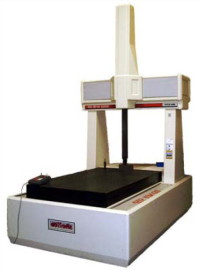
|
| |
|
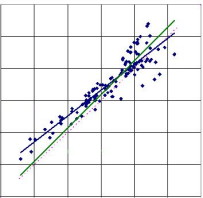
BEST FIT ?
|
There can be other errors unless the CMM operator is
very careful about their set up. This generated autoplane can have errors that were caused by not leveling the
work properly with screw jacks or by not mapping thickness variation prior to checking straightness. Still it's
hard to argue with a nice CMM printout that is often several pages long. This argument however has been won more
than a few times when some CMM operator rejected a part that had previously checked okay with a straight edge that
had also checked okay against a NIST certified
granite plate. The comparative flatness check of precision straight edges can be hard to deny from an accuracy
standpoint. There is nothing like seeing no light gap between the part or the granite plate, and the straight edge.
That single visual image of quality usually beats all that computer mumbo-jumbo. I never cease to be amazed when
CMM operators attempt to explain why their part inspection numbers changed because they'd moved the part into another
location on the CMM table or fixtures. The simplicity of a straight edge is easy to understand and seldom requires
complicated explanations. |
| |
|
Aluminum
Straight Edges - We can make aluminum
straight edges. They weigh about 1/3 the amount of a steel straight edge. They are also about 1/3 as strong with
the Young's modulus for aluminum at 10,000,000 PSI compared to 30,000,000 PSI for steel. Aluminum straight edges
are simply not as durable because they bend and nick much easier than steel.
We also make a few standard straight edges for leveling applications that are made from Aluminum. These straight
edges were designed to be used with precision levels for machine installations. The ligher weight compensates
for the extra width required to hold the base of the level and wear is not a factor for this application. |
| |
|
|
|
|
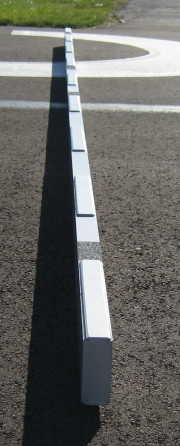
|
I often asked about bonding a steel edge on an aluminum
straight edge. It's a great idea but unless it's done very carefully it may compromise the the flatness and straightness
tolerance unless it's used at only one temperature. Aluminum expands with temperature at 1.68 times faster than
steel. When a steel edge is firmly attached to and aluminum base the difference in the coefficient of thermal expansion
will cause the unit to bow with a temperature change. This property is great if you are building a bi-metal strip
for a thermostat but not so helpful for precision straight edges. For a 120-inch long unit a 10 degree F temperature
change will cause steel to expand 0.0087-inch while the aluminum will expand 0.0147-inch. This 0.006-inch difference
may not be a problem when measuring asphalt but is not acceptable for precision straight edge used to align machinery.
We also make aluminum straight edges with a steel edge for pavement inspection. The stainless steel strip is attached
to the aluminum with a flexible bond that allows for expansion due to temperature change. Our 16-foot long PaveFlat unit is very light at only 33 lbs compared to 285 lbs for
an equivalent solid steel unit. This superlight alumium unit has a flatness that is only held within 0.012-inch
compared to 0.004-inch maximum deviation for our solid steel straight edge. The cost for either longer unit is
about the same, but a shorter aluminum/steel unit is more expensive that a sold steel straight edge. |
|
| Woodworking
Fence Edge - Maybe my standards are too high, but I'd like a straight
edge that checks the same on a granite plate each time I attempt to verify its straightness. I usually need to
use a tool that is straight and flat within a very few thousands of an inch. I've never aligned woodworking equipment,
so I don't know how much accuracy is required or if some of very cheap aluminum units sold by woodworking supply
companies actually work for their intended purpose. I'm fairly certain that if these companies use an aluminum
extrusion it is not very straight as extruded. Did you ever notice they never seem to mention the tolerance they
hold for straightness? I do know that we seem to sell our fair share of steel straight edges to firms that make
wood products on a production basis. |
|
| |
 |
